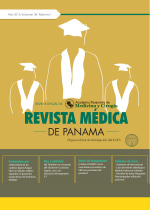Necesidades insatisfechas de planificación familiar y factores relacionados en hombres de cinco países de Latinoamérica
Autores/as
DOI:
https://doi.org/10.37980/im.journal.rmdp.20221840Palabras clave:
igualdad de género, planificación familiar, hombres, métodos modernos, derechos sexuales y reproductivosResumen
Objetivos: Estimar la necesidad insatisfecha de planificación familiar con métodos modernos identificando factores relacionados en hombres de Colombia, Guatemala, Haití, Honduras y Panamá.
Métodos: Este estudio transversal utilizó datos de encuestas representativas a nivel nacional en Colombia, Guatemala, Haití, Honduras y Panamá para analizar entrevistados casados/unidos de 15-59 años con necesidades de planificación familiar. La relación de factores con la necesidad insatisfecha se probó mediante regresión logística multivariable.
Resultados: La necesidad insatisfecha era mayor en Haití (46.5%), seguido por Panamá (43.0%), Guatemala (36.8%), Honduras (21.3%) y Colombia (12.4%). Las oportunidades relativas ajustadas de necesidad insatisfecha aumentaron con la edad en todos los países; eran mayores en pertenecientes a pueblos indígenas de Colombia, Guatemala, Honduras y Panamá; en quienes vivían en hogares con menor bienestar en Guatemala, Honduras y Panamá; y en quienes informaron uniones formales en Guatemala y Honduras. Las oportunidades de necesidad insatisfecha disminuyeron con mayor escolaridad en Haití; con mayor conocimiento de métodos modernos en Guatemala y Honduras; si discutieron sobre planificación familiar con algún profesional/trabajador de salud en Haití y Panamá; y si recibieron información sobre planificación familiar en medios de comunicación en Colombia.
Conclusiones: Existen factores demográficos, socioeconómicos, de acceso a información y comportamiento relacionados con la necesidad insatisfecha. Incluir a los hombres en los programas de planificación familiar y en el desarrollo de intervenciones culturalmente aceptadas contribuiría a acelerar el logro del ejercicio responsable y voluntario del derecho a decidir si reproducirse, cuándo y con qué frecuencia.
Publicado
Número
Sección
Licencia
Derechos de autor 2022 Infomedic Intl.Derechos autoriales y de reproducibilidad. La Revista Médica de Panama es un ente académico, sin fines de lucro, que forma parte de la Academia Panameña de Medicina y Cirugía. Sus publicaciones son de tipo acceso gratuito de su contenido para uso individual y académico, sin restricción. Los derechos autoriales de cada artículo son retenidos por sus autores. Al Publicar en la Revista, el autor otorga Licencia permanente, exclusiva, e irrevocable a la Sociedad para la edición del manuscrito, y otorga a la empresa editorial, Infomedic International Licencia de uso de distribución, indexación y comercial exclusiva, permanente e irrevocable de su contenido y para la generación de productos y servicios derivados del mismo. En caso que el autor obtenga la licencia CC BY, el artículo y sus derivados son de libre acceso y distribución.






